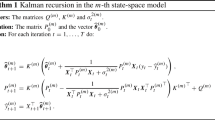Abstract
In this paper, we consider the problem of online probabilistic time series forecasting. The difference between a probabilistic prediction (distribution function) and a numerical outcome is measured using a loss function (scoring rule). In practical statistics, the Continuous Ranked Probability Score (CRPS) rule is often used to estimate the discrepancy between probabilistic predictions and quantitative outcomes. Here, we consider the case when several competing methods (experts) give their predictions in the form of distribution functions. Expert predictions are provided with confidence levels. We propose an algorithm for online aggregation of these distribution functions with allowance for the confidence levels to expert forecasts. The discounted error of the proposed algorithm with allowance for the confidence levels is estimated in the form of a comparison of the cumulative losses of the algorithm and the losses of experts. A technology for constructing predictive expert algorithms and aggregating their probabilistic predictions using the example of the problem of predicting electricity consumption 1 or more hours ahead was developed. The results of numerical experiments using real data are presented.













Similar content being viewed by others
Notes
Here, 1u ≥ y = 1 if u ≥ y, and it is 0 otherwise.
The nature of these sets will be specified later.
The distribution function is non-decreasing function F(y) defined on interval [a, b] such that F(a) = 0 and F(b) = 1. It is also continuous on the left and has a limit on the right at every point.
REFERENCES
N. Cesa-Bianchi and G. Lugosi, Prediction, Learning, and Games (Cambridge Univ. Press, Cambridge, 2006).
Y. Freund and R. E. Schapire, “A decision-theoretic generalization of on-line learning and an application to boosting,” J. Comp. & System Sci. 55, 119–139 (1997).
V. Vovk, “Aggregating strategies,” in M. Fulk and J. Case, ed., Proc. 3rd Annual Workshop on Computational Learning Theory, San Mateo, CA, 1990 (Morgan Kaufmann, 1990), pp. 371–383.
N. Littlestone and M. Warmuth, “The weighted majority algorithm,” Inf. and Comput. 108, 212–261 (1994).
V. V. V’yugin and V. G. Trunov, “Online aggregation of probabilistic forecasts on the basis of the scoring rule of the continuous ranged probability,” Inf. Prots. 19 (2), 92–112 (2019).
V. V’yugin and V. Trunov, “Online learning with continuous ranked probability score,” Proc. Machine Learning Res. 105, 163–177 (2019).
A. Jordan, F. Krüger, and S. Lerch, “Evaluating probabilistic forecasts with scoring rules,” arXiv: 1709.04743.
L. A. Bröcker and L. A. Smith, “Scoring probabilistic forecasts: The importance of being proper,” Weather and Forecasting 22, 382–388 (2007).
J. Bröcker and L. A. Smith, “From ensemble forecasts to predictive distribution functions,” Tellus A 60, 663–678, (2008).
J. Bröcker, “Evaluating raw ensembles with the continuous ranked probability score,” Q. J. R. Meteorol. Soc. 138, 1611–1617 (2012).
A. E. Raftery, T. Gneiting, F. Balabdaoui, and M. Polakowski, “Using Bayesian model averaging to calibrate forecast ensembles,” Mon. Weather Rev. 133, 1155–1174 (2005).
K. Bogner, K. Liechti, and M. Zappa, “Technical note: Combining quantile forecasts and predictive distributions of streamflows,” Hydrol. Earth Syst. Sci. 21, 5493–5502 (2017).
J. Thorey, V. Mallet, and P. Baudin, “Online learning with the Continuous Ranked Probability Score for ensemble forecasting,” Quart. J. R. Meteorolog. Soc., Jan. 143, 521–529 (2017). https://doi.org/10.1002/qj.2940
V. Vovk, “A game of prediction with expert advice,” J. Computer and System Sciences 56 (2), 153–173 (1998).
V. V’yugin and V. Trunov, “Online aggregation of unbounded losses using shifting experts with confidence,” Machine Learning 108, 425–444 (2019).
Tao Hong, Pierre Pinson, Shu Fanc, Hamidreza Zareipour, Alberto Troccoli, and Rob J. Hyndman, “Probabilistic energy forecasting: Global Energy Forecasting Competition 2014 and beyond,” Int. J. Forecasting 32, 896–913 (2016).
V. Vovk, “Competitive on-line statistics,” Int. Statis. Review 69, 213–248 (2001).
E. S. Epstein, “A scoring system for probability forecasts of ranked categories,” J. Appl. Meteorol. Climatol. 8, 985–987 (1969).
G. W. Brier, “Verification of forecasts expressed in terms of probabilities, Mon. Weather Rev. 78, 1–3 (1950).
I. J. Good, “Rational decisions,” J. R. Statist. Soc. B 14, 107–114 (1952). https://www.jstor.org/stable/2984087.
J. E. Matheson and R. L.Winkler, “Scoring rules for continuous probability distributions,” Management Sci. 22, 1087–1096 (1976). https://doi.org/10.1287/mnsc.22.10.1087
A. Blum and Y. Mansour, “From external to internal regret,” J. Machine Learning Res. 8, 1307–1324 (2007).
A. Chernov and V. Vovk, “Prediction with expert evaluators advice,” Algorithmic Learning Theory, ALT, Proc. LNCS (Springer) 5809 8–22, (2009).
M. Herbster and M. Warmuth, “Tracking the best expert,” Machine Learning 32 (2), 151–178 (1998).
https: // www.kaggle.com /datasets.
M. Devaine, P. Gaillard, Y. Goude, and G. Stoltz, “Forecasting electricity consumption by aggregating specialized experts,” Machine Learning 90, 231–260 (2013).
G. McLachlan and D. Peel, Finite Mixture Models (Wiley and Sons, Hoboken, NJ, 2000).
Z. I. Botev, J. F. Grotowski, and D. P. Kroese, “Kernel density estimation via diffusion,” Ann. Statist. 38, 2916–2957 (2010).
Funding
This work was partially supported by the Russian Foundation for Basic Research, grant no. 20-01-00203.
Author information
Authors and Affiliations
Corresponding author
Ethics declarations
The authors declare that they do not have a conflict of interest.
Additional information
Translated by A. Ivanov
Rights and permissions
About this article
Cite this article
V’yugin, V.V., Trunov, V.G. Online Aggregation of Probabilistic Predictions of Hourly Electrical Loads. J. Commun. Technol. Electron. 67, 702–716 (2022). https://doi.org/10.1134/S1064226922060201
Received:
Revised:
Accepted:
Published:
Issue Date:
DOI: https://doi.org/10.1134/S1064226922060201




